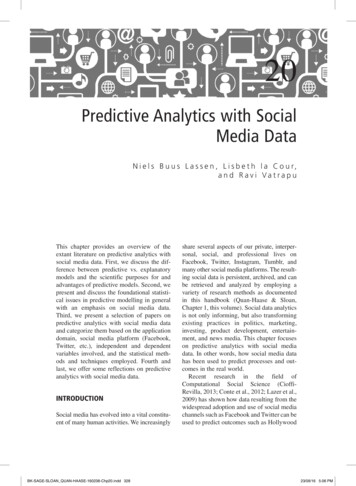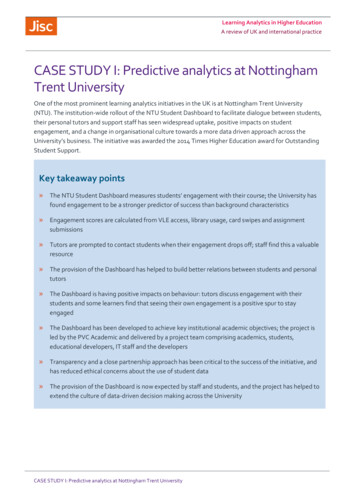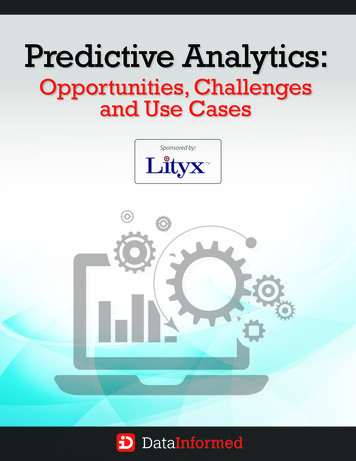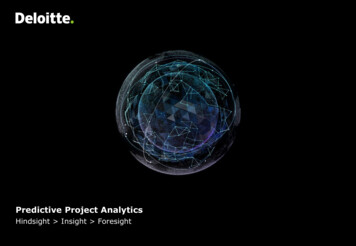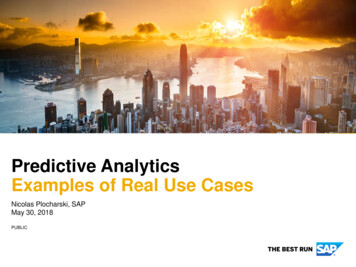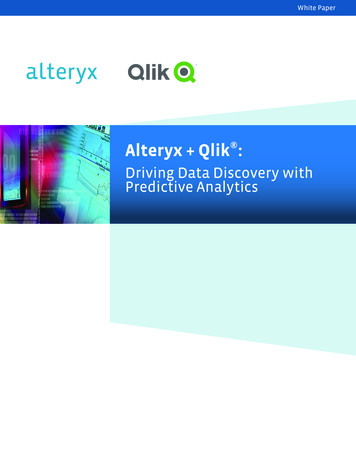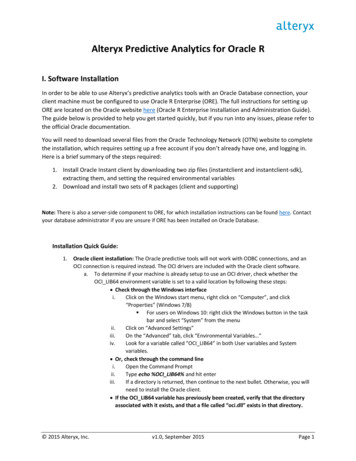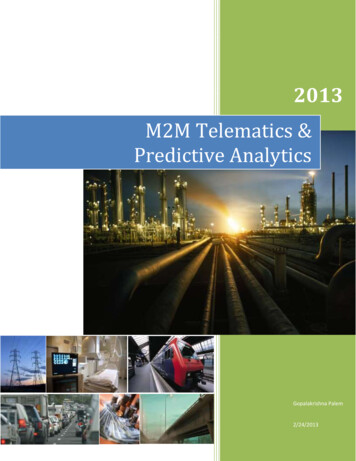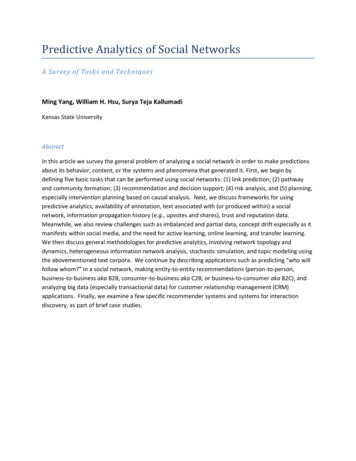
Transcription
Predictive Analytics of Social NetworksA Survey of Tasks and TechniquesMing Yang, William H. Hsu, Surya Teja KallumadiKansas State UniversityAbstractIn this article we survey the general problem of analyzing a social network in order to make predictionsabout its behavior, content, or the systems and phenomena that generated it. First, we begin bydefining five basic tasks that can be performed using social networks: (1) link prediction; (2) pathwayand community formation; (3) recommendation and decision support; (4) risk analysis, and (5) planning,especially intervention planning based on causal analysis. Next, we discuss frameworks for usingpredictive analytics, availability of annotation, text associated with (or produced within) a socialnetwork, information propagation history (e.g., upvotes and shares), trust and reputation data.Meanwhile, we also review challenges such as imbalanced and partial data, concept drift especially as itmanifests within social media, and the need for active learning, online learning, and transfer learning.We then discuss general methodologies for predictive analytics, involving network topology anddynamics, heterogeneous information network analysis, stochastic simulation, and topic modeling usingthe abovementioned text corpora. We continue by describing applications such as predicting “who willfollow whom?” in a social network, making entity-to-entity recommendations (person-to-person,business-to-business aka B2B, consumer-to-business aka C2B, or business-to-consumer aka B2C), andanalyzing big data (especially transactional data) for customer relationship management (CRM)applications. Finally, we examine a few specific recommender systems and systems for interactiondiscovery, as part of brief case studies.
1. Introduction: Prediction in Social NetworksSocial networks provide a way to anticipate, build, and make use of links, by representating relationshipsand propagation of phenomena between pairs of entities that can be extended to large-scale dynamicalsystems. In its most general form, a social network can capture individuals, communities or otherorganizations, and propagation of everything from information (documents, memes, and rumors) toinfectious pathogens. This representation facilitates the study of patterns in the formation, persistence,evolution, and decay of relationships, which in itself forms a type of dynamical system, and alsosupports modeling of temporal dynamics for events that propagate across a network.In this first section, we survey goals of predictive analytics using a social network, outline the specifictasks that motivate the use of graph-based models of social networks, and discuss the general state-ofthe-field in data science as applied to prediction.1.1Overview: Goals of PredictionIn general, time series prediction aims to generate estimates for variables of interest that are associatedwith future states of some domain. These variables frequently represent a continuation of the inputdata, modeled under some assumptions about how the future data are distributed as a function of thehistory of past input, plus exogenous factors such as noise. The term forecasting refers to this specifictype of predictive task. (Gershenfeld & Weigend, 1994) Acquiring the information to support thisoperation is known as modeling and frequently involves the application of machine learning andstatistical inference. A further goal of the analytical process that informs this model is understandingthe way in which a generative process changes over time; in some scenarios, this means estimating highlevel parameters or especially structural elements of the time series model.Getoor (2003) introduces the term link mining to describe a specialized form of data mining: analyzing anetwork structure to discover novel, useful, and comprehensible relationships that are often latent, i.e.,not explicitly described. Prototypical link mining tasks, as typified by the three domains that Getoorsurveys, include modeling collections of web pages, bibliographies, and the spread of diseases. Eachmember of such a collection represents one entity. In the case of web page networks, links can beoutlinks directed from a member page to another page, inlinks directed from another page to a memberpage, or co-citation links indicating that some page contains outlinks to both endpoints of a link.Bibliography or citation networks model paper-to-paper citations, co-author sets, author-to-institutionlinks, and paper-to-publication relationships. Epidemiological domains are often represented usingcontact networks, which represent individual organisms (especially humans or other animals) usingnodes and habitual or incidental contact using links. Spread models extend this graphical representationby adding information about incubation and other rates and time-dependent events.Getoor and Diehl (2005) further survey the task of link mining, taxonomizing tasks into abstractcategories such as object-based, link-based, and graph-based. Object-based tasks, used often in
information retrieval and visualization, include ranking, classification, group detection (one instance ofwhich is community detection), and identification (including disambiguation and deduplication). Linkbased tasks, which we discuss in depth in this article, include the modeling task of link prediction –deducing or calculating the likelihood of a future link between two candidate entities, based on theirindividual attributes and mutual associations. Graph-based tasks include modeling tasks such asdiscovering subgraphs, as well as characterization or understanding tasks such as classifying an entiregraph as a small-world network or being governed by a random generative model – e.g., some type ofErdős–Rényi graph (Erdős & Rényi, 1960).Social media have proliferated and gained in user population, bandwidth consumed, and volume ofcontent produced since the early 2000s. A brief history and broad survey of social network sites is givenby boyd and Ellison (2007), documenting different mechanisms by which online social identity ismaintained and computer-mediated communication practiced. This article also introducescontemporary work on characterization and visualization of network structure, modeling offline andonline social networks using a combined model, and preservation of privacy on social network sites(SNSs). Many of the modeling tools referenced in this survey paper admit direct application orextension to predictive analytics tasks for SNSs. (Yu, Han, & Faloutsos, 2010)1.2TasksPredictive analytics refers to the application of statistical and other computational tools to historicaldata, towards achieving goals of prediction listed in Section 1.1, with the purpose of identifyingactionable patterns. These may be positive patterns that the end user wishes to promote and leverage,such as frequent web browsing sequences or social communities, or negative patterns representingphenomena to be counteracted, such as incipient epidemics and criminal networks. Link mining andprediction in social media exist as outgrowths and extensions of predictive analytics in general, but theapplications thereof are formulated in service to specific goals. This section gives an overview of thesegoals and their supporting technical objectives. These are expressed in terms of task definitions:performance elements such as decision support, recommender systems, and risk management, to whichthe methodology of predictive analytics is applicable. In decision support systems, the goal is to provideassistive technology for generating and explaining a recommended course of action to a human user orusers. We will see how decision support tasks for social networks can be understood in terms of link,pathway, and community prediction, giving rise to more specialized tasks such as the detection of at-riskgroups and modeling the dynamics of information propagation to recognize and act on patterns in socialnetworks.1.2.1Link Prediction
Liben-Nowell and Kleinberg (2007) formalize the link prediction problem as that of answering thequestion:Given a snapshot of a social network, can we infer which new interactions among its members arelikely to occur in the near future?They relate this task to the atemporal problem of inferring missing links from a partially observednetwork and characterize solution approaches as being based upon node neighborhoods, existing pathsin the known network, and “meta-approaches” that are compatible with node and path-based methods.Node-based scores that are positively correlated with the existence of a link (𝑢, 𝑣) between nodes 𝑢 and𝑣 include: the count of their common neighbors in an undirected graph model; multiplicative or othernonlinear functions of their respective graph degrees, such as preferential attachment; and similaritymeasures used in information retrieval such as inverse log frequency of feature co-occurrence. Pathbased scores are often based on the count or a parametrically weighted sum of alternative path lengthsbetween 𝑢 and 𝑣. Stochastic sampling-based variants of this type of score include the expected time fora random walk originating from 𝑢 to reach 𝑣 (the hitting time). Liben-Nowell and Kleinberg discussMarkov chain Monte Carlo approaches, including random walk with restart (Al Hasan, Ahmed, & Neville,2013), towards estimation of path-based scores for the link prediction task. They also discuss howmeta-level approximation methods, such as those resembling latent semantic analysis (Deerwester,Dumais, Furnas, Landauer, & Harshman, 1990), can be used to estimate the score for a candidate link(𝑢, 𝑣).Link prediction tasks may apply to graphs that are treated as unchanging over time (static) ordynamic. (Salem, 2009) In the case of static graphs, the task is to discover possibly hidden links frompartial information. In the case of dynamic graphs, social network data is treated as a historicalsnapshot (Barabási, et al., 2002) and the task is to predict a continuation of the data, as in traditionaltime series. Recovering these missing links in the graph may be viewed as a reconstruction task fora hierarchical structure (Clauset, Moore, & Newman, 2008). This can be done by analyzing localstructure or through transformations of the spectral density of edges across the graph (Kunegis &Lommatzsch, 2009). The local structure itself can represent general relationships in an entityrelational data model (Taskar, Wong, Abbeel, & Koller, 2004) or friendship and trust in social media(Hsu, Lancaster, Paradesi, & Weninger, 2007).The existence of a relationship existing between two users in a social network can be identified byan inference process or by simple classification. Although the inference steps may be probabilistic,logical, or both, the links themselves tend to be categorical. They can be dependent purely on singlenodes, local topology, or exogenous information. (Hsu, Lancaster, Paradesi, & Weninger, 2007) Inaddition to using the structure of the known graph, common features of candidates for linkexistence (friendship, trust, or mutual community membership) include text-based similaritymeasures such as the number of common interests or some semantically-weighted sum thereof.(Caragea, Bahirwani, Aljandal, & Hsu, 2009) Al Hasan and Zaki (2011) provide a broad survey of
extant link prediction techniques, emphasizing the feature types surveyed earlier by Liben-Nowelland Kleinberg (2007). Recent work has focused on topic modelling approaches to the existence offriendship links in social networks (Parimi & Caragea, 2011) and to the development and use ofspatial features in location-based social media (Scellato, Noulas, & Mascolo, 2011). Though thesenetworks can theoretically contain hundreds of millions to billions of vertices, most empiricalscientific studies to date have focused on data sets containing thousands to tens of millions ofvertices. (Caragea, Bahirwani, Aljandal, & Hsu, 2009)1.2.2Degrees of Separation: Pathway and Community FormationThe task of link prediction can be extended to the general problem of finding paths and subgraphs(communities), a general class of problems which may involve the systematic application of localanalytical techniques (USA Patent No. US 7069308, 2003; Backstrom, Huttenlocher, Kleinberg, & Lan,2006) or holistic analysis of the entire social network. Nonlocal analysis is often based on having aglobal topic model that is used as a similarity measure between users to detect community structure,(Qian, Zhang, & Yang, 2006) This is a case of the general observed phenomenon and theory ofhomophily, the tendency of similar individuals to associate with one another. (McPherson, Smith-Lovin,& Cook, 2001) The purpose and typical performance elements of such a system are to understand thelikely participation profiles of users: how long, how often, and with what frequency and volume ofinformation propagation they are likely to participate. (Nov, Naaman, & Ye, 2009) Recent studies oncomputer-mediated communication have indicated that both internal observable factors such as auser’s tenure (longevity of membership and role), and external ones such as a user’s motivation forusing a photo-sharing site, are relevant to these usage statistics. (Nov, Naaman, & Ye, 2010)Meanwhile, techniques for predicting the formation of links such as follower linkage in social media arelargely based on graph structure, i.e., topology. (Romero & Kleinberg, 2010) Other features that are notpurely topological may be overlaid on or otherwise combined with an existing social network. (Brown,Nicosia, Scellato, Noulas, & Mascolo, 2012) In addition, the basic tonal quality of posts by social networkusers, particularly sentiments expressed about topics of mutual interest, are a commonly-used basis forcommunity formation. (Nguyen, Phung, Adams, & Venkatesh, 2012)1.2.3Prediction with RecommendationOne important function of a social network that is of particular importance to third-party providers ofinformation and services is recommendation, the identification to users of information, services, andmerchandise which they may be interested in. Recommender systems in social media are most oftenbased on a model of intrinsic and tacit trust among users associated with the recipient ofrecommendations. Insofar as association is an indication of similarity of interests and preferences, thisleads to a natural mechanism for collaborative filtering and ranking of recommendations. (O'Donovan &Smyth, 2005) This idea has subsequently been extended to systematic analyses of sparse user-itemratings matrices, weighted by similarity measures between users that are computed using these
matrices, in order to make use of this normalization mechanism, a type of social regularization. (Ma,Zhou, Liu, Lyu, & King, 2011) This can also be used to recommend explicit association between users,especially a recommendation to follow another user’s postings. (Ma, Yang, Wang, & Yuan, 2014)In this article, we will introduce predictive methods based solely on this type of behavior within a socialnetwork and those that are based on, or augmented using, user profile information.1.2.4Risk Prediction and Identifying Risk GroupsAnother important function of link prediction in social networks is the systematic identification of at-riskgroups based on exposures that can be inferred from social contacts and known features. This oftentakes the form of contagious disease exposure, a topic that is heavily studied in the literature and whichwe will examine in this article; however, graph structure can reveal other information such as thesupport structure available to aged persons and their level of isolation. (Wenger, 1997)This type of information can further be used to understand the intrinsic properties and identifyingcharacteristics of risk groups. Furthermore, it can in some cases, such as in Wenger’s study, providesome basic quantitative measures of risk levels and early-warning criteria for emergent problems, suchas in elder care and community health.1.2.5Planning and InterventionOnce a mechanism exists for identifying groups that exhibit or admit elevated risk, it may be possible touse social network structure and content in order to plan for, and act during, emergencies. Thisincludes disaster preparedness and intervention planning (National Research Council (S. L. Magsino,Rapporteur), 2009), as well as social mobilization for “time-critical feats, ranging from mapping crises inreal time, to organizing mass rallies, to conducting search- and-rescue operations over largegeographies”. (Rutherford, et al., 2013) The limiting factor here is proximity, which differentiates mostinterventional models for social crisis management from flash mobs, which in turn constrains therecruitment potential and response time.Predictive analytics also provides a data-driven basis for optimization of coordination strategies, such asassignment and scheduling of rescue units in a natural disaster scenario such as a flood or landslide. Theprediction targets include early crisis warning metrics for such specific risks, extracted from social textand message propagation. (Wex, 2013) The emerging field of computational disaster managementincludes time-critical aspects of preparation, response, rescue, relief, and repair or cleanup effort in theaftermath of a disaster. Optimization and intelligent systems tasks exist at all stages of this process.(Van Hentenryck, 2013)1.3Approaches: Prediction in Data Science
Because of the large scale of social networks, the largest of which currently number in the hundreds ofmillions to low billions of users, each with as many as several thousand relationships, the generalproblem area of prediction in social media falls under the rubric of “analytics using big data”. Users ofpredictive analytics technology are often interested in decision support approaches that beyond thecrisis intervention, risk management, and recommendation systems listed above. This presents newchallenges to developers of analytics systems. (LaValle, Lesser, Shockley, Hopkins, & Kruschwitz, 2011)In this article, we will delve into the data sciences and specific methodologies (Davenport & Patil, 2012)behind presently used and emerging systems for prediction in social media. The methodologies for bigdata tend to be more enterprise-wide than limited to analytics or information technology units of theclient organization. (Davenport, Barth, & Bean, 2012) Additionally, scalable data integration fromheterogeneous sources, such as are prevalent in big data, presents more data management issues thantraditional analytics – particularly with respect to data definitions (metadata and ontologies). (Chen,Chiang, & Storey, 2012; Davenport, Barth, & Bean, 2012)2. Background2.1Predictive Analytics in Social NetworksThe term predictive analytics generally refers to the development and federated display of models forthe future state of a system based on observed data. As Wex (2013) notes, digital media outlets such asonline news provide knowledge sources and a mechanism by which historical data (and text corpora)can help improve understanding on the emergence of crises:With a main focus on online news and a ubiquitous information overload, crisismanagers are constantly confronted to masses of publicly available, yet unstructureddata sources. Online news cannot be clearly characterized as being “real-time” unlikee.g. ad-hoc messages, thus making it difficult to explain the latency between theoccurrence of an event and its proclamation. Yet, news stories often possess meta-datasuch as geographical tagging, an accumulation of similar reports, keywords, orsubjective author belief which calls for the application of superior analytical methods, i.e.text mining, to investigate hidden statistical relationships between the gradualemergence of a crisis and its medial proclamation. However, expertise and knowledge ofhow to transform this data into machine-readable information and how to engage inprediction methods is frequently non-existent.
The challenges of predictive analytics applied to social media include data integration, cleaning, andvisualization. (Thomas & Kielman, 2009) Thomas and Kielman identify the following ten needs of visualanalytics technologies and systems:1. Whole-part relationships: the ability to represent hierarchies in a scale-independent way2. Relationship discovery: the capability to discover interrelationships among people, places,times, and other attributes and features, using techniques from information retrieval (indexingfor phrase-based search), relational databases (query by example), and data mining (clusteringand classification)3. Combined exploratory and confirmatory interaction: a cognitive model for interactivehypothesis testing4. Multiple data types: adaptive hypermedia and multimedia, task-adaptive views andrepresentations, and a content repurposing capability5. Temporal views and interactions: the ability to represent temporal dynamics of processes,including (causal) flows, timelines, and event and milestone visualizations6. Groupings and outlier identification: labeling and annotation of clusters, and the application ofclustering to outlier detection7. Multiple linked views: materialized views supporting the application of data transformationactions committed on one view to data displayed using other views8. Labeling: user-controllable, contextualized views for dynamic visualization and data modeling9. Reporting: the ability to save and reproduce analytical operations and results for publication10. Interdisciplinary science: accessibility by users and subject matter experts with differentexpertise and backgroundPredictive analytics applications that deal with social media are numerous, especially in business, andtend to focus around assistive technologies for customers as users, or decision support systems forcustomer relationship management and business intelligence. (Taylor, 2011)2.1.1Foundational Graph Theory and Link AnalyticsMuch of the methodology that supports link mining is based on analytical graph algorithms as the basisof predicting the existence or behavior of a link. (Washio & Motoda, 2003) The function of algorithmsincludes compilation of frequent pattern bases, in a manner similar to frequent itemset mining; gSpan(Yan & Han, 2002) is one of the earliest such algorithms and CloseGraph (Yan & Han, 2003) is its closedsubgraph analogue. Some relational data mining systems use only such graph-based algorithms, whilesome also use logical constraints and properties as expressed using inductive logic programming.(Ketkar, Holder, & Cook, 2005) Ketkar et al. report results of experimental evaluation that illustratestradeoffs: these results indicate that graph-based multirelational data mining algorithms perform betterthat logic-based ones on structurally complex networks, while the logic-based is best for semanticallycomplex content, and the accuracy of relationship prediction is comparable for generic, semanticallyshallow, medium-sized networks.
Getoor (2003) introduced a catalog of link mining applications in the earliest survey of extant machinelearning and data mining research applied to graph structure. Methodological advances since then haveincluded both visual analytics and statistical analytics, and have focused on generalizing over bothstructure and content to recover network structure. (Shen, Ma, & Eliassi-Rad, 2006) Some of this earlywork on heterogeneous information network structure focuses semantic graphs with different entitytypes – hence the term “heterogeneous” – and the need to account for these semantics through sometype of quantitative or formal ontology in estimating link strength.Link analytics is an informal term that refers to the systematic analysis of graph topology and statistics inorder to build a holistic predictive model. Algorithmic subtasks of link analytics include enumerationmaximal cliques, a parallelizable task (Du, Wu, Xu, Wang, & Pei, 2006) and using large matrixfactorization (Acar, Dunlavy, & Kolda, 2009). More recently Olsman, Roxendal, and Åkerblom (2013)have adapted network models of organizational theory to capture the behavior of organizational socialnetworks.2.1.2Time Series Analysis: Forecasting, Modeling, and UnderstandingSection 1 introduced the notions of forecasting, modeling, and understanding – terms from theliterature of the time series analysis community, subareas such as signal identification, and related areassuch as signal processing. We refer the interested reader to seminal references on the topic, especialy:Box, Jenkins, and Reinsel (2008), Chatfield (2004), and the introduction to time series modeling byGershenfeld and Weigend (1994) in the anthology of time series analytics papers based on the Santa FeTime Series Competition.2.1.3Statistical Modeling of Network DynamicsBesides network topology, the task of predicting the behavior and output of a social network mayinvolve network dynamics and thus fall under the purview of dynamical systems modeling. Themathematical foundations for this modeling include chaos theory (Gregersen & Sailer, 1993) and bothstatistical and graph-theoretic analysis of network topology as a determinant of dynamics (Borgatti,Mehra, Brass, & Labianca, 2009).2.2Using Network-Associated ContentMuch of the early domain literature in content-based social network modeling and prediction originatesfrom collaboration graphs and in particular citation graphs, where nodes represent papers andsometimes authors, and links represent citations. The CiteSeer system is one of the first of these (Giles,Bollacker, & Lawrence, 1998). The original system included an autonomous web agent that crawled anddigested publication pages of academic authors in computer science (Bollacker, Lawrence, & Giles,
1998), extracting the local web of citations for all papers and linked preprints or reprints it identified.This autonomous citation indexing mechanism (Lawrence, Giles, & Bollacker, 1999) represents a broaderclass of document-based information federation (aka data integration or information integration) andinformation extraction systems based on web crawling and scraping. The resultant network modelingalgorithms that emerged from this work support collaborative filtering of search results based onpersonality diagnosis of search engine users using memory-based and model-based inductive learningsystems (Pennock, Horvitz, Lawrence, & Giles, 2000), and were later shown to be compatible withcontent-based filtering in data-sparse environments (Popescul, Ungar, Pennock, & Lawrence, 2001).Achieving high-recall link mining systems was shown to require more than simply maximizing scores in asystem where publications competed for citations or other links (Pennock, Flake, Lawrence, Glover, &Giles, 2002).More recently, the method of combining both content-based and collaborative filtering approaches hasbeen applied to document categorization in scientific domains (Cao & Gao, 2005) and to online text ingeneral (Angelova & Weikum, 2006). A profile of relevant work to date appears in a survey on web datamining research by Singh and Singh (2010).2.2.1User Profile DataWeb mining systems, going beyond simple link mining, often use user profile data (Cooley, Mobasher, &Srivastava, 1997). One application of this approach is towards user modeling, personalization, andadaptive synthesis of hypermedia (Mobasher, Cooley, & Srivastava, 2000); another is to use nodespecific data (i.e., single user data) in the link existence prediction task (Hsu, King, Paradesi, Pydimarri, &Weninger, 2006) and in understanding characteristic content-based features of their own accord, and inrelation to subgraph patterns in social networks (Thelwall, 2008). This approach has been used todevelop and refine data models for crawled social network data (Catanese, De Meo, Ferrara, Fiumara, &Provetti, 2011), to annotate user features with social relationships (Sun, Lin, Chen, & Liu, 2013), and tocapture user self-description in microblogging sites such as Twitter (Semertzidis, Pitoura, & Tsaparas,2013).2.2.2Temporal Event DataBesides graph structure and content related to users or other individual nodes, we may consideridentifiable events associated with originating nodes, which may propagate through the networkstructure. These events, which are often spatiotemporal in nature or can be associated with locationand time, can in turn yield detected social network structure (Lauw, Lim, Pang, & Tan, 2011), and can beused to predict subsequent events and rank predictions (O'Madadhain, Hutchins, & Smyth, 2005). Werefer the reader to Aggarwal (2011) for a general introduction to this type of data analytics.2.2.3Free Text Corpora
The idea of a semantic network dates back to work by Woods (1975), who considered the heterogeneityof nodes and links, and discussed ways in which link structure can be inferred from data andobservations. Later researchers explored the use of free text corpora – i.e., collections of documents fornatural language text in unrestricted form – in this task (Mladenic, 1999). Blog and forum posts areoften published online but are sometimes available only to registered users, limiting their general use astest beds. By the middle of the 2000s, a surge in formation of social network sites (SNSs) led toincreased interest in e-mail corpora (Culotta, Bekkerman, & McCallum, 2004), especially authorrecipient-topic models that could be built from public corpora such as the Enron e-mail corpus(McCallum, Corrada-Emmanuel, & Wang, 2005). The problem of discovering the roles of author andrecipient in a behavioral rubric or schema then gained interest (McCallum, Wang, & Corrada-Emmanuel,2007), both as a means of extracting social computing models from free text corpora but as a way toaugment topic modeling (Chang, Boyd-Graber, & Blei, 2009). By 2010, the use of social media as
Predictive Analytics of Social Networks A Survey of Tasks and Techniques Ming Yang, William H. Hsu, Surya Teja Kallumadi Kansas State University Abstract In this article we survey the general problem of analyzing a social network in order to make predictions about its behavior,
